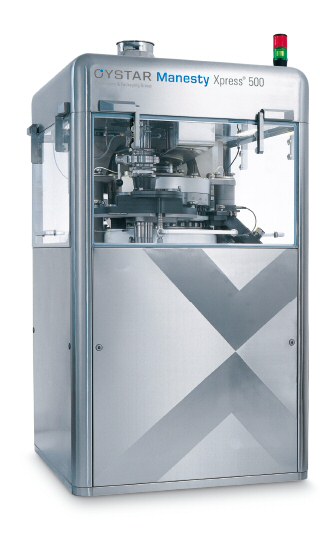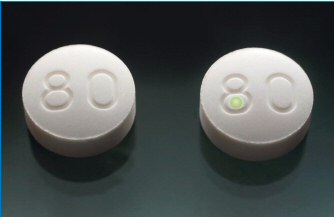Manesty debuts production-speed verification tech
Phil Taylor, 14-Jul-2009
 While many companies developing anti-counterfeiting technologies focus on product packaging, production machinery specialist Oystar Manesty has taken a different tack.
While many companies developing anti-counterfeiting technologies focus on product packaging, production machinery specialist Oystar Manesty has taken a different tack.
The company - best known for its range of tablet presses and coating machines - has developed a marker system that integrates directly with a pharmaceutical manufacturer’s existing production line and adds an authentication technology directly to the tablet or capsule.
Oystar Manesty’s managing director, Matthias Meyer, gave a presentation of the system’s key principles at IQPC’s Anti-Counterfeiting Pharma conference in Wiesbaden.
“Making tablets is a mass production, with speeds running at up to 1 million units per hour. You need to have a system that can cope with that production rate without any change in product appearance,” he said.
Oystar Manesty’s technology, called NanoTrust, meets these requirements, he said. It adds a forensic signature to individual tablets via the application of luminescent nanoparticles (LNPs) onto a tablet during compression, using a module that can be included in a new Manesty tablet press or retrofitted to a customer’s existing equipment.
Critically, the system allows precise, reproducible positioning of the LNP droplet. That provides an added layer of protection, and opens up the possibility of combining the forensic signal with an overt marker, for example a coloured dot as part of the brand design of a tablet.
 “It is extremely difficult to incorporate a defined, discrete dot in a tablet without the colour migrating. You could not reproduce this visible marker by adding a dab of food colouring,” said Meyer.
“It is extremely difficult to incorporate a defined, discrete dot in a tablet without the colour migrating. You could not reproduce this visible marker by adding a dab of food colouring,” said Meyer.
Each application of the particles carries a unique emission profile that can be read using an infrared laser scanner, allowing identification of tablets down to the batch level, he added. The signal can also be read through a tablet coating – which is important as 80 per cent of all tablets on the market are coated.
Oystar Manesty was determined to come up with an authentication solution that could be incorporated into a manufacturer’s existing production process with a minimal increase in production cost, Meyer told SecuringPharma.com in an interview.
Adding the particles to a pharmaceutical product costs around 0.1 euro cents per tablet, he said, and the system has two levels of identification.
A basic scanner costing as little as €100, giving a yes/no answer to an authentication query, could be used in the field by customs officers or other agencies. Meanwhile, more sophisticated scanners can be used to extract the signature information and identify the batch the tablet came from, he noted.
The LNPs can be combined to provide infinite numbers of unique codes which cannot be re-engineered. Moreover, the person carrying out the authentication needs to know the precise IR wavelength to use to generate the excitation signal.
At the moment a key question for Oystar Manesty as it moves from the development to the pre-commercial phase for NanoTrust is how regulators will respond to the addition of the LNP marker into a dosage form.
While conceding this is still up for debate, Meyer said he does not believes this will be a major obstacle as the LNP material is inert and inorganic, non-toxic and is added in tiny quantities – less than 5mcg per tablet – which is a lower level than many impurities.
Compounds in the same class have already been awarded Generally Recognised As Safe (GRAS) status by the US Food and Drug Administration (FDA), giving the go-ahead for their use as food additives for animals, he added. The particles have also been used as marker materials to detect cancer cells in humans.
And despite concerns about the potential side effects of nanoparticles on the human body, the LNPs – typically measuring between 100nm and 1 micron, are much larger than the 50nm threshold which is considered critical for particulate toxicity.
FDA guidance could provide a framework
An encouraging development for Oystar Manesty is that the US Food and Drug Administration (FDA) has just published a guidance document on physical chemical identifiers (PCIDs) - inks, pigments and flavours etc – that provides a framework for this type of technology.
The draft guidance – just published in the Federal Register - provides recommendations to pharmaceutical manufacturers on design considerations for incorporating PCIDs into solid oral dosage forms as well as the supporting documentation that should be submitted in marketing applications. [Ed: Check back soon for a review of that guidance document].
“We believe the combination of on-pack and on-dose technologies provides a high level of trust in the authenticity of a product,” said Meyer.
In addition to tablets, it is also feasible to add the NanoTrust market to capsules and, because the particles are heat-resistant, the technology might also be added to a vial.



©
SecuringIndustry.com




 While many companies developing anti-counterfeiting technologies focus on product packaging, production machinery specialist Oystar Manesty has taken a different tack.
While many companies developing anti-counterfeiting technologies focus on product packaging, production machinery specialist Oystar Manesty has taken a different tack. “It is extremely difficult to incorporate a defined, discrete dot in a tablet without the colour migrating. You could not reproduce this visible marker by adding a dab of food colouring,” said Meyer.
“It is extremely difficult to incorporate a defined, discrete dot in a tablet without the colour migrating. You could not reproduce this visible marker by adding a dab of food colouring,” said Meyer.